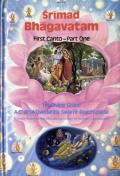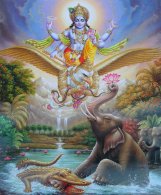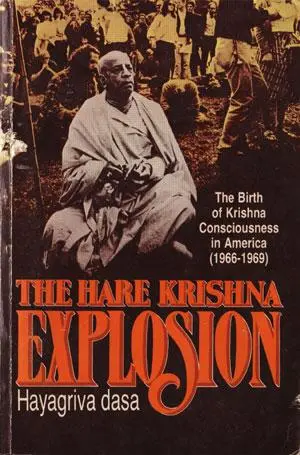It seems that every time I start a new volume of the Srimad Bhagavatam, I open it and read the Preface first. I must have read the preface now many times, but every time I read it, it seems fresh and new. One could argue that it because my memory is poor, or, that is just the nature of transcendental literature. But what is interesting is to me this morning, is how I never looked up the verse that Srila Prabhupada quotes in his Preface:
kaumāra ācaret prājñodharmān bhāgavatān ihadurlabhaṁ mānuṣaṁ janmatad apy adhruvam arthadam (Bhāg. 7.6.1)
This morning I was curious, so I went to the Seventh Canto, Chapter 6, Text 1, and it read:
Prahlāda Mahārāja said: One who is sufficiently intelligent should use the human form of body from the very beginning of life—in other words, from the tender age of childhood—to practice the activities of devotional service, giving up all other engagements. The human body is most rarely achieved, and although temporary like other bodies, it is meaningful because in human life one can perform devotional service. Even a slight amount of sincere devotional service can give one complete perfection.
Full text and purport follows the Preface
Śrīmad-Bhāgavatam
By His Divine Grace A. C. Bhaktivedanta Swami Prabhupāda
Preface
We must know the present need of human society. And what is that need? Human society is no longer bounded by geographical limits to particular countries or communities. Human society is broader than in the Middle Ages, and the world tendency is toward one state or one human society. The ideals of spiritual communism, according to Śrīmad-Bhāgavatam, are based more or less on the oneness of the entire human society, nay, of the entire energy of living beings. The need is felt by great thinkers to make this a successful ideology. Śrīmad-Bhāgavatam will fill this need in human society. It begins, therefore, with the aphorism of Vedānta philosophy janmādy asya yataḥ [Bhāg. 1.1.1] to establish the ideal of a common cause.
Human society, at the present moment, is not in the darkness of oblivion. It has made rapid progress in the field of material comforts, education and economic development throughout the entire world. But there is a pinprick somewhere in the social body at large, and therefore there are large-scale quarrels, even over less important issues. There is need of a clue as to how humanity can become one in peace, friendship and prosperity with a common cause. Śrīmad-Bhāgavatam will fill this need, for it is a cultural presentation for the respiritualization of the entire human society.
Śrīmad-Bhāgavatam should be introduced also in the schools and colleges, for it is recommended by the great student-devotee Prahlāda Mahārāja in order to change the demoniac face of society.
kaumāra ācaret prājñodharmān bhāgavatān ihadurlabhaṁ mānuṣaṁ janmatad apy adhruvam arthadam (Bhāg. 7.6.1)
Disparity in human society is due to lack of principles in a godless civilization. There is God, or the Almighty One, from whom everything emanates, by whom everything is maintained and in whom everything is merged to rest. Material science has tried to find the ultimate source of creation very insufficiently, but it is a fact that there is one ultimate source of everything that be. This ultimate source is explained rationally and authoritatively in the beautiful Bhāgavatam, or Śrīmad-Bhāgavatam.
Śrīmad-Bhāgavatam is the transcendental science not only for knowing the ultimate source of everything but also for knowing our relation with Him and our duty toward perfection of the human society on the basis of this perfect knowledge. It is powerful reading matter in the Sanskrit language, and it is now rendered into English elaborately so that simply by a careful reading one will know God perfectly well, so much so that the reader will be sufficiently educated to defend himself from the onslaught of atheists. Over and above this, the reader will be able to convert others to accepting God as a concrete principle.
Śrīmad-Bhāgavatam begins with the definition of the ultimate source. It is a bona fide commentary on the Vedānta-sūtra by the same author, Śrīla Vyāsadeva, and gradually it develops into nine cantos up to the highest state of God realization. The only qualification one needs to study this great book of transcendental knowledge is to proceed step by step cautiously and not jump forward haphazardly like with an ordinary book. It should be gone through chapter by chapter, one after another. The reading matter is so arranged with its original Sanskrit text, its English transliteration, synonyms, translation and purports so that one is sure to become a God-realized soul at the end of finishing the first nine cantos.
The Tenth Canto is distinct from the first nine cantos because it deals directly with the transcendental activities of the Personality of Godhead Śrī Kṛṣṇa. One will be unable to capture the effects of the Tenth Canto without going through the first nine cantos. The book is complete in twelve cantos, each independent, but it is good for all to read them in small installments one after another.
I must admit my frailties in presenting Śrīmad-Bhāgavatam, but still I am hopeful of its good reception by the thinkers and leaders of society on the strength of the following statement of Śrīmad-Bhāgavatam (1.5.11):
tad-vāg-visargo janatāgha-viplavo
yasmin prati-ślokam abaddhavaty api
nāmāny anantasya yaśo ’ṅkitāni yac
chṛṇvanti gāyanti gṛṇanti sādhavaḥ
“On the other hand, that literature which is full with descriptions of the transcendental glories of the name, fame, form and pastimes of the unlimited Supreme Lord is a transcendental creation meant to bring about a revolution in the impious life of a misdirected civilization. Such transcendental literatures, even though irregularly composed, are heard, sung and accepted by purified men who are thoroughly honest.”
Oṁ tat sat
A. C. Bhaktivedanta Swami
Dated at Delhi
December 15, 1962
Śrīmad-Bhāgavatam
By His Divine Grace A. C. Bhaktivedanta Swami Prabhupāda
Seventh Canto, Chapter 6, Text 1
śrī-prahrāda uvāca
kaumāra ācaret prājño
dharmān bhāgavatān iha
durlabhaṁ mānuṣaṁ janma
tad apy adhruvam arthadam
śrī-prahrādaḥ uvāca—Prahlāda Mahārāja said; kaumāraḥ—in the tender age of childhood; ācaret—should practice; prājñaḥ—one who is intelligent; dharmān—occupational duties; bhāgavatān—which are devotional service to the Supreme Personality of Godhead; iha—in this life; durlabham—very rarely obtained; mānuṣam—human; janma—birth; tat—that; api—even; adhruvam—impermanent, temporary; artha-dam—full of meaning.
TRANSLATION
Prahlāda Mahārāja said: One who is sufficiently intelligent should use the human form of body from the very beginning of life—in other words, from the tender age of childhood—to practice the activities of devotional service, giving up all other engagements. The human body is most rarely achieved, and although temporary like other bodies, it is meaningful because in human life one can perform devotional service. Even a slight amount of sincere devotional service can give one complete perfection.
PURPORT
The whole purpose of Vedic civilization and of reading the Vedas is to attain the perfect stage of devotional service in the human form of life. According to the Vedic system, therefore, from the very beginning of life the brahmacarya system is introduced so that from one’s very childhood—from the age of five years—one can practice modifying one’s human activities so as to engage perfectly in devotional service. As confirmed in Bhagavad-gītā (2.40), svalpam apy asya dharmasya trāyate mahato bhayāt: “Even a little advancement on this path can protect one from the most dangerous type of fear.” Modern civilization, not referring to the verdicts of Vedic literature, is so cruel to the members of human society that instead of teaching children to become brahmacārīs, it teaches mothers to kill their children even in the womb, on the plea of curbing the increase of population. And if by chance a child is saved, he is educated only for sense gratification. Gradually, throughout the entire world, human society is losing interest in the perfection of life. Indeed, men are living like cats and dogs, spoiling the duration of their human lives by actually preparing to transmigrate again to the degraded species among the 8,400,000 forms of life. The Kṛṣṇa consciousness movement is anxious to serve human society by teaching people to perform devotional service, which can save a human being from being degraded again to animal life. As already stated by Prahlāda Mahārāja, bhāgavata-dharma consists of śravaṇaṁ kīrtanaṁ viṣṇoḥ smaraṇaṁ pāda-sevanam/ arcanaṁ vandanaṁ dāsyaṁ sakhyam ātma-nivedanam [SB 7.5.23]. In all the schools, colleges and universities, and at home, all children and youths should be taught to hear about the Supreme Personality of Godhead. In other words, they should be taught to hear the instructions of Bhagavad-gītā, to put them into practice in their lives, and thus to become strong in devotional service, free from fear of being degraded to animal life. Following bhāgavata-dharma has been made extremely easy in this age of Kali. The śāstra says:
harer nāma harer nāma
harer nāmaiva kevalam
kalau nāsty eva nāsty eva
nāsty eva gatir anyathā
[Adi 17.21]
One need only chant the Hare Kṛṣṇa mahā-mantra. Everyone engaged in the practice of chanting the Hare Kṛṣṇa mahā-mantra will be completely cleansed, from the core of his heart, and be saved from the cycle of birth and death.
















Oct 20, 2016 @ 18:56:00
Thank you so much. <3